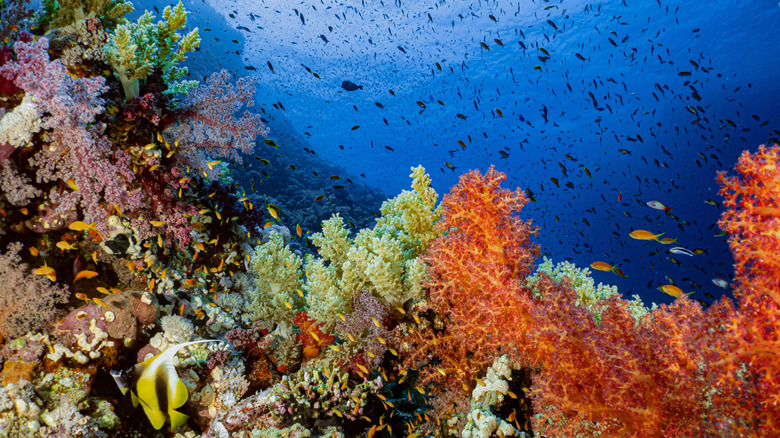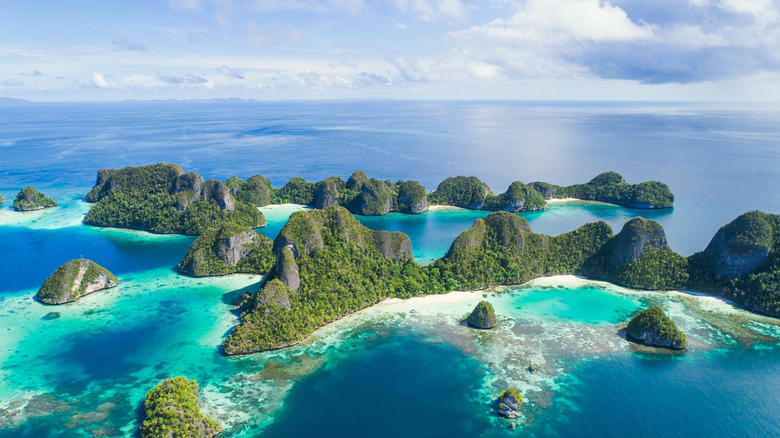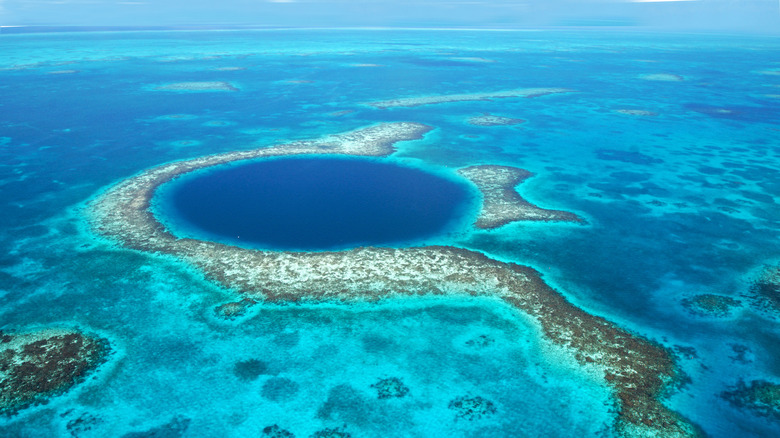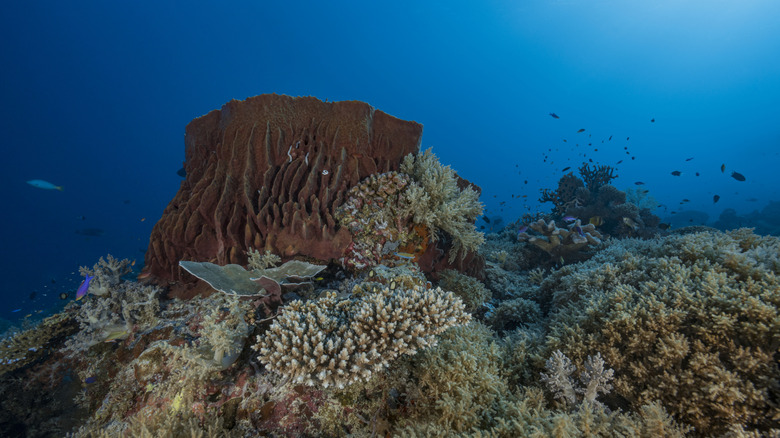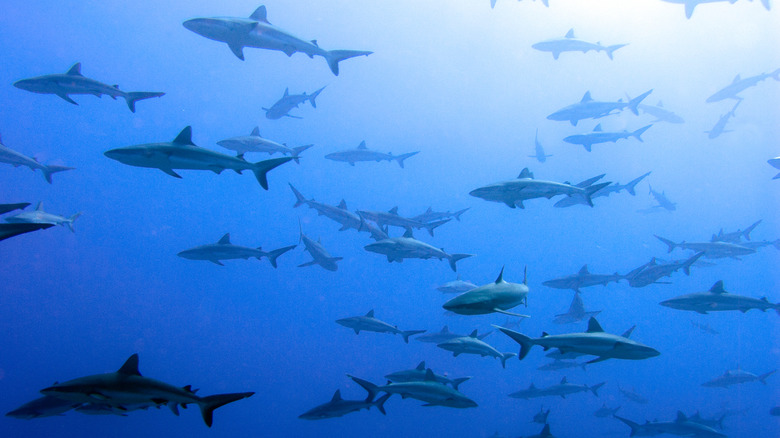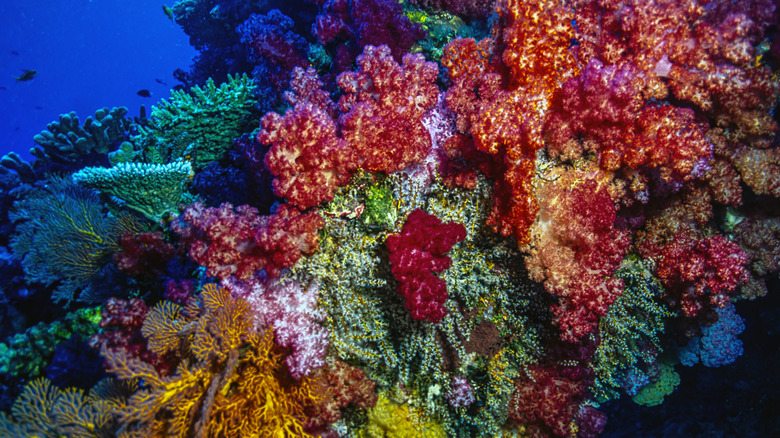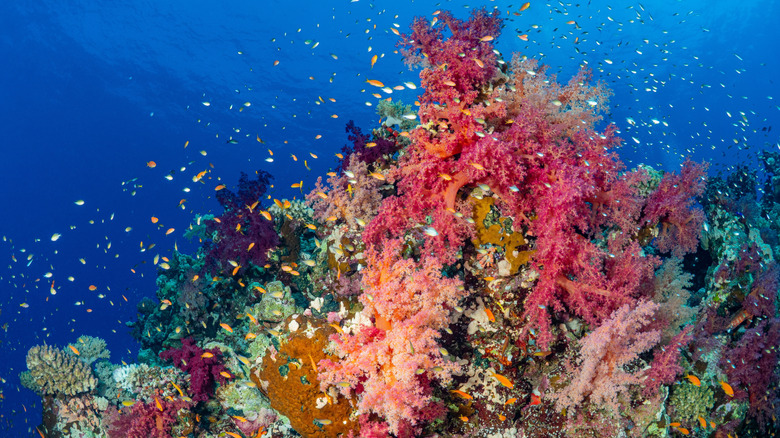The Best Coral Reefs To Dive (Other Than The Great Barrier Reef), According To Travelers
Every reef has its own personality, but a few stand out with good reason. While the Great Barrier Reef is undeniably a world-class dive experience, other coral reefs do a spectacular job illustrating the sheer magnificence of the underwater world. From the atolls of Belize to an expansive Indonesian archipelago, these coral reefs will instill even the most jaded diver with a sense of awe.
This list considers overall coral health, marine biodiversity, as well as the ease and safety of the diving experiences. It also pinpoints special draws that make a diving destination particularly noteworthy. For instance, a bucket list migratory event, rare native animals, or a unique marine feature that can't be found anywhere else.
However, it's important to note that coral reefs worldwide are under threat due to rising ocean temperatures, coastal development projects, extreme weather events, and other factors. Therefore, classifying any coral reef system (especially a large one) as "healthy" doesn't capture the full picture. Before visiting these reefs, assess the specific dive sites you want to visit and get in contact with a reputable dive center for up-to-date information about the waters.
Raja Ampat, Indonesia
There's a reason Raja Ampat tops lists of the most beautiful diving destinations in the world. Far away from the crowded destinations in Bali, Indonesia, Raja Ampat is actually an archipelago of 1,500 islands. Meaning "Four Kings" in Indonesian, the area offers a truly royal show of biodiversity, including over 570 types of coral and 1,400 species of fish. For reference, a staggering 75% of the world's coral species reside here. And, the reefs are healthy and as untouched as you can find in a world run by people.
As you glide through warm, clear waters, catch glimpses of native wobbegongs walking around the seafloor, giant manta rays, and hammerhead sharks. Beginner divers can't miss the sea sponge- and soft coral-covered floors of Melissa's Garden, while current-heavy Cape Kri treats advanced divers to an incredible array of critters in a single dive. While there are tons of dive sites, it's hard to go wrong in Raja Ampat. "I will continue to visit these islands for the rest of my life," shared one return diver on Tripadvisor. "They are heaven on earth for nature lovers ... one thing this place does is ruin your experiences for other locations."
Getting to Raja Ampat takes a bit of work. You'll need to land in Jakarta, fly four hours to Sorong, travel by ferry to Waisai, and then take another boat to wherever you plan to stay. However, the stilted eco-resorts on uninhabited islands and liveaboard diving experiences will make the journey worth it.
The Belize Barrier Reef, Belize
Another marine wonder that gets overshadowed by the Great Barrier Reef is the Belize Barrier Reef. Extending 180 miles in the Caribbean Sea, it's the second-biggest reef in the world and home to over 1,400 marine species. Once listed as "in danger" by the UNESCO World Heritage Committee, the reef is now a success story for how protective policies and community-led conservation can turn the tide on environmental destruction. Unfortunately, since 2023, the reef has faced unprecedented bleaching, but there's still much beauty to be found.
Today, the famed coral atolls, sparkling cays, and kaleidoscope-like coral formations draw divers from all over the world. Dive with whale sharks beneath the full moon at Gladden Split, or observe manatees, manta rays, and 48 delicate hard coral species in the protected waters of Turneffe Atoll's 70 dive sites. However, you can't plan a dive trip to Belize without visiting the Great Blue Hole. Plunging over 400 feet, it's the world's largest underwater sinkhole and can be seen from space. As you descend into the jet-black darkness, black fin and reef sharks replace sun-loving corals and schools of fish.
Charles Darwin went as far as calling it "the most remarkable reef in the West Indies" — high praise from someone who traveled so extensively. However, timing your trip correctly is of the utmost importance. Hurricane season brings unpredictable weather and potentially cloudy waters between June and November, so you'll want to plan your dives from December to April.
Tubbataha Reef, The Philippines
Situated in the Sulu Sea, off the coast of Puerto Princesa, Tubbataha Reef is a dreamy destination for divers who appreciate truly impressive coral gardens that wriggle and sway with life. This UNESCO World Heritage Site is one of the only places that can truly compete with Raja Ampat in regard to coral quality. Cruise past barrel sponges big enough to hold a person and admire walls covered in over 360 coral species. A diver who visited in May 2025 shared that even though the water was warm, the corals remained unaffected and plentiful.
"It would suffice to say that when you break that surface water barrier and open your eyes under water: Behold the vista of colours, shapes of corals as far as eye can see," exclaimed another diver on Tripadvisor. "Take the young ones with you to show them what they will be inheriting and it is their duty to preserve it." Besides corals and wispy sea fans, divers can expect hammerhead sharks, hawksbill turtles, and all sorts of reef fish.
Tubbataha Reef can only be explored via liveaboard boat, which limits the number of people and human-produced debris. The diving season is short-lived for the sake of conservation, lasting from mid-March to mid-June. It's important to keep in mind that some of the boats are older, so you'll want to choose carefully and be cautious of any price that seems too good. There are quite a few reputable liveaboard operators that set sail for the Philippines, including Aggressor Adventures.
Fakarava Reef, French Polynesia
Technically a coral atoll about 260 miles from Tahiti, Fakarava Reef seems more like a gateway to another universe, teaming with hundreds of sharks at a time and technicolor corals. In fact, Fakarava is one of the rare places in the world where you can dive with a hypnotic wall of gray sharks that seem to pass by in unending quantities. During the day, they ride the ocean currents, using as little energy as possible. But, at night, the lagoon surrounding the atoll becomes their hunting ground.
However, the sharks are only part of the story. "The south pass of [F]akarava in [F]rench [P]olynesia was the most rich and alive reef environment [I've] ever seen," shared a recent visitor on Reddit. As a UNESCO Biosphere Reserve, the waters are well-protected and maintaining reef health is a top priority. At the South Pass, you'll encounter the "wall of sharks" as well as some of the healthiest coral gardens in the area, rays, and reef sharks.
At Fakarava Reef, there are really only two sections to dive at (North and South). The same current that attracts the sharks can present a challenge to inexperienced divers. Generally speaking, you're more likely to encounter intense currents in the North Pass, but this isn't always the case. After you've finished diving for the day, lounge beneath palms on the white- and pink-sand beaches or relax in a thatched-roof bungalow.
Rainbow Reef, Fiji
Often called the "soft coral capital of the world," Fiji's Rainbow Reef is the place to go for a technical color tapestry of corals and undulating ribbons of mesmerizing reef fish. While it might be hard to imagine, the corals are so vibrant that some divers prefer Rainbow Reef to Raja Ampat. Nestled along the Somosomo Strait, just off the dive-centric island of Taveuni, the reef showcases at least 400 types of coral that create a habitat for over 1,200 species of fish.
Divers can choose from about 20 sites, ranging from beginner-friendly dives with the gentlest drifts to the more advanced Great White Wall. Named for the wall of white corals that appear to glow against the dark blue water, The Great White Wall is one of the most famous dive sites in the world. Soft corals dressed in lavender and bright magenta add pops of color to this ethereal scene, thanks to the nutrient-rich waters flowing by. Other can't-miss dives for coral enthusiasts include the shallow coral gardens at The Cabbage Patch and Annie's Bommie, an underwater mountain covered in a soft coral forest and circled by huge schools of fish.
A far cry from the adrenaline-pumping shark dives of Fakarava, Rainbow Reef brings a slower pace and the chance to experience the oceans as art. As a bonus, Taveuni is often considered the best island in Fiji to visit for unparalleled waterfall hikes, with Tovoro's cascades putting on a particularly jaw-dropping show.
Methodology
As previously mentioned, this list defines the "best coral reefs for diving" as ones that have healthy coral communities, rich biodiversity, and a good selection of dive operations that prioritize diver safety. We also selected places with once-in-a-lifetime dive experiences, like encountering a vortex of sharks or witnessing a coral garden so bright it appears to glow from the depths.
Our research includes the advice of experienced divers on reddit, Tripadvisor, PADI, and ScubaBoard combined with data from the World Wildlife Fund, UNESCO, and country-specific tourism authorities. Our ranking is also based on the writer's experience drift diving in Southeast Asia and research conducted for future trips.
You'll notice we haven't included the Red Sea, a destination divers praise for its incredible water clarity and thriving reefs overflowing with over 1,000 species. Although the biodiversity is astounding, the Red Sea earns a lower ranking than other reefs on the list due to safety issues with liveaboard vessels. This includes 16 accidents since 2020 caused by boats in poor repair and inadequate lifesaving equipment. However, there are many reputable outfitters, so the Red Sea earns an honorable mention.
